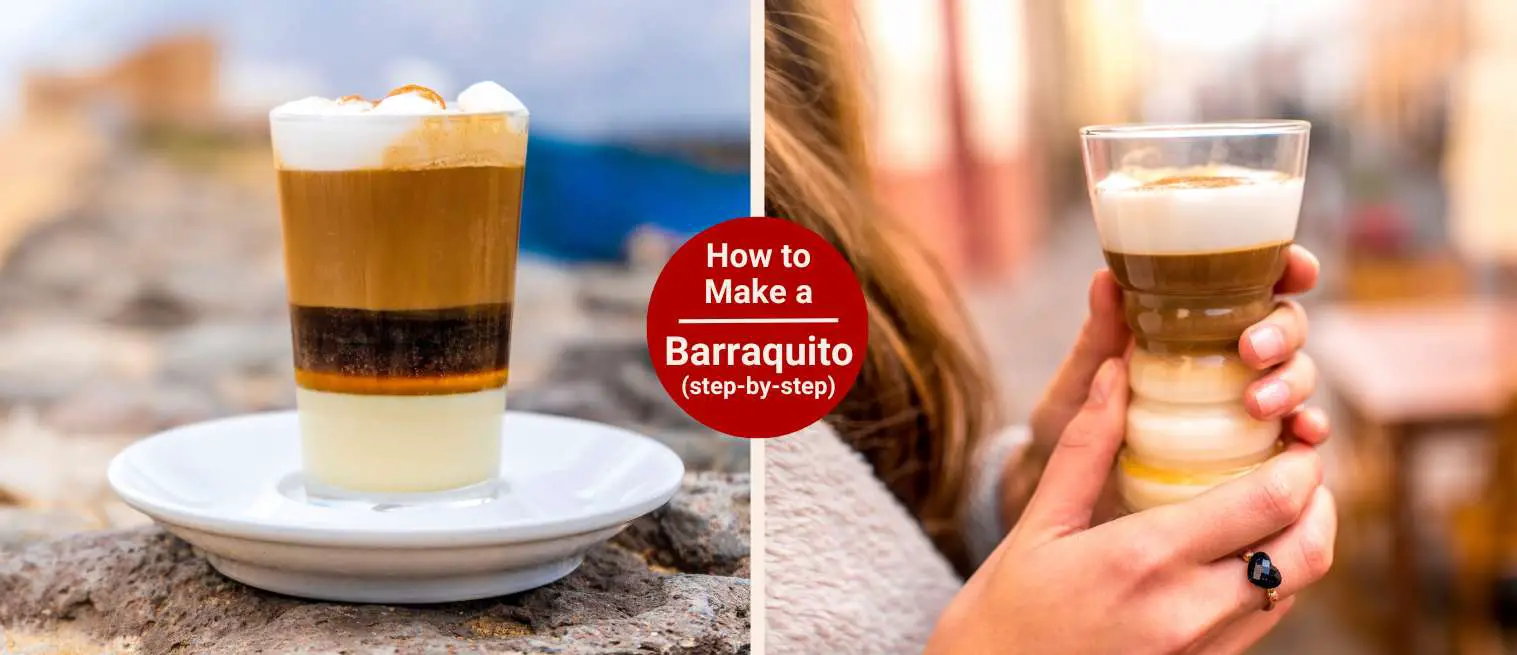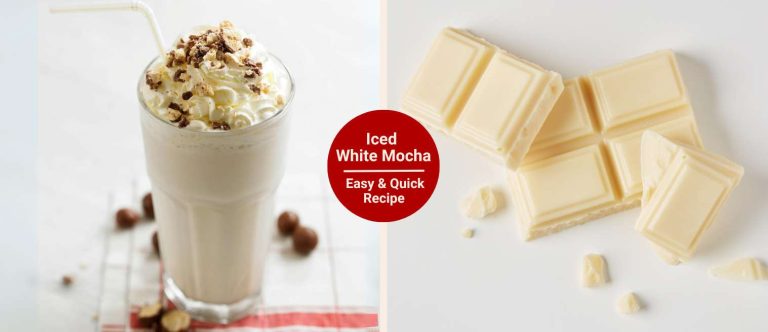How To Make a Barraquito (Easy Tenerife Cocktail Recipe)
Last updated on August 14th, 2025 at 10:36 am
Ever stumbled on a drink so good it made you pause mid-sip?
That was me with the Barraquito. I wasn’t looking for anything special. I walked into a small café in Tenerife and saw this beautiful layered drink glide by on a tray.
I asked the barista what it was, and next thing I knew, I was sipping something that tasted like dessert and espresso had a perfect baby.
Sweet, bold, creamy, with a citrus twist… I was hooked instantly.
No joke! Now, it’s one of my favorites when I want to impress friends or treat myself on a slow afternoon.
In this guide, I’ll walk you through exactly how to make a traditional Barraquito at home. This includes the ingredients and gear you’ll need to the layering tricks that give it that café-worthy look. So let’s start brewing!
What Is a Barraquito?
Barraquito is a beautifully layered glass of coffee, sweetened condensed milk, Licor 43, espresso, and frothy milk. Then it’s topped with lemon zest and a dash of cinnamon. Basically, it’s dessert dressed up as coffee.
The drink comes from Tenerife in the Canary Islands, where it’s a staple in local cafés. No two cafés make it exactly the same. However, the main ingredients are almost always the same.
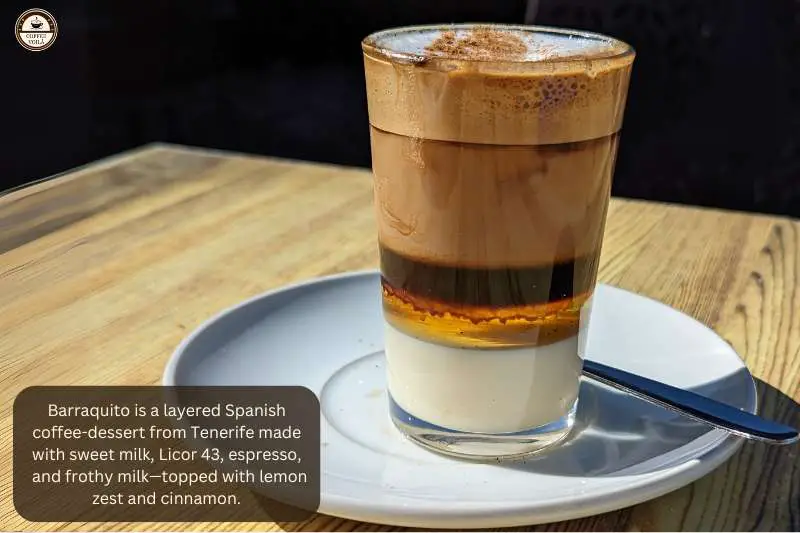
This includes sweet milk at the bottom, liqueur, espresso in the middle, then airy milk foam up top. That contrast of dark and light layers?
It’s a big part of the experience. You drink it slowly, letting the sweetness and boldness swirl together with every sip.
In terms of flavor, you can expect something between a spiked latte and a creamy dessert.
You get the warmth from the Licor 43 (which tastes like vanilla and citrus), the richness of condensed milk, and the punch of espresso, all mellowed out by the frothy milk.
Where & When Is It Typically Served?
Usually, Barraquito is served after a meal. Often as a little treat when you’re too full for cake but still want something sweet.
This coffee is particularly common in Tenerife. However, you’ll find it throughout the Canary Islands in both locals-only joints and more touristy cafés.
From what I’ve seen, locals love it as much as travelers do. It’s not just a gimmick. Instead, it’s part of the coffee culture.
Brief History of Barraquito
Most people agree that the drink first started turning heads in the 1950s in Santa Cruz de Tenerife. One of the most popular origin stories involves a regular customer nicknamed “Barraquito” who’d swing by a café near the port’s famous Marquesina every morning.
He ordered a custom carajillo with condensed milk, Licor 43, and frothed milk and the name kinda stuck.
Now, others will tell you a bartender from the bar Los Paragüitas invented it on a slow day. Or that a man named Manolo Grijalbo made it for his artsy clientele across from the Santa Cruz casino.
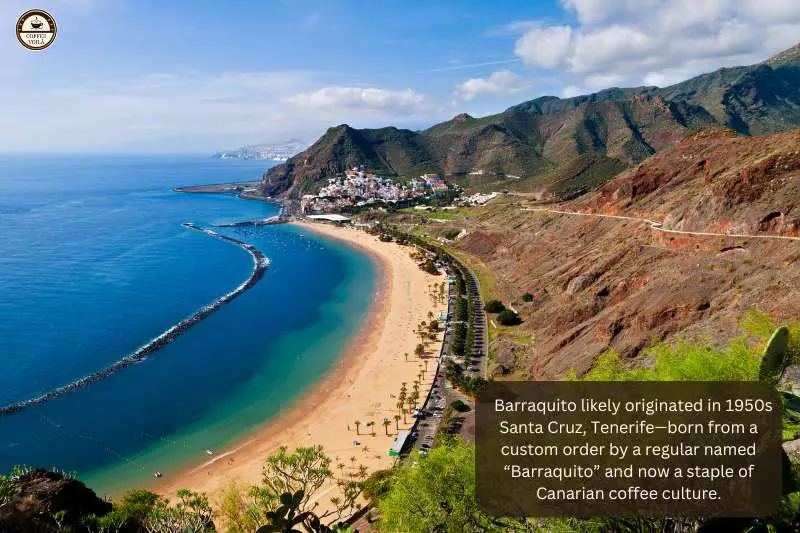
Then you’ve got folks in northern Tenerife, especially around Puerto de la Cruz, who swear their version, called zaperoco, came first and includes even more Licor 43.
And to spice it up a bit more, there’s also the Café Asiático from Cartagena on the mainland. This uses almost the same ingredients.
But ask a local and they’ll be quick to say, “Nah, that’s totally different.”
What’s clear is this: whether it was born from one man’s breakfast habit or a barista’s creative flair, the Barraquito has become a beloved part of Canarian coffee culture.

How to Make a Barraquito (Step-by-Step Guide)
Equipment
- Clear glass or small latte glass – transparency is key to show off those beautiful layers
- Espresso machine or moka pot – whichever method gives you a rich, strong shot
- Milk frother or steam wand – you’ll want foam with a velvety texture
- Teaspoon or long spoon – for slowing down your pour and layering like a pro
Ingredients
- 2 tablespoons sweetened condensed milk – thick and sweet, this forms the base layer
- 1 ounce Licor 43 – a Spanish vanilla-citrus liqueur that brings warmth and sweetness
- 1 shot of espresso – strong and fresh, preferably from an espresso machine or moka pot
- 2–3 tablespoons frothed milk – airy but stable, enough to form the top
- Lemon zest (optional) – just a pinch adds brightness
- Ground cinnamon – for garnish and a bit of spice
Instructions
- Add Sweetened Condensed Milk: Start by spooning about two tablespoons of sweetened condensed milk into the bottom of your glass. Because it’s dense, it’ll sit at the bottom without much effort. Make sure it’s evenly spread to create a nice, solid first layer.
- Add Licor 43: Next comes the Licor 43. You hold a spoon just above the condensed milk, rounded side down, and gently pour the liqueur over the back of it. This keeps the layers from mixing. You’ll start to see a golden band sitting on top of the milk.
- Add Espresso: Brew your espresso shot and let it sit for about 10 seconds. This reduces the crema a bit, making it easier to pour cleanly. Again, pour it slowly over the back of your spoon. The espresso should rest on top of the Licor 43 without diving in too fast.
- Add Frothed Milk: Now take your frothed milk. Whether from a steam wand or handheld frother and spoon in only the foam. This creates that fluffy white top layer. Also, don’t pour too fast, or it’ll break the layers below. Think of it like placing a soft cloud on top of your drink.
- Garnish: Top it all off with a tiny pinch of ground cinnamon and, if you like, a few curls of lemon zest. The cinnamon adds warmth, and the lemon zest gives it a fresh, unexpected twist.
Video
Notes
Pro Tip:
Let each layer rest for 5–10 seconds before adding the next one. This pause helps prevent mixing and keeps the layers sharp. If your espresso is too hot or your foam too loose, things will swirl together.Tips for Perfect Layering
I’ve definitely had my fair share of “blended disasters” that still tasted great but looked like someone shook the glass. If you want that café-level presentation, these simple tricks make a huge difference.
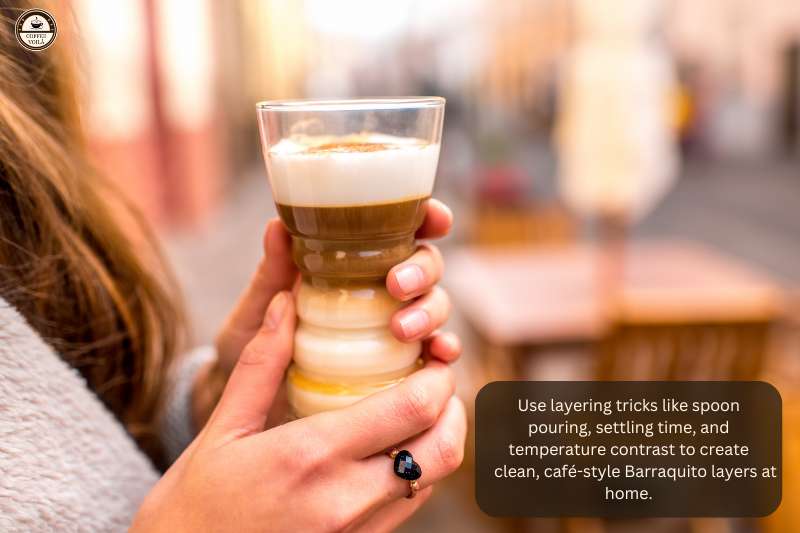
1 – Use the Back of a Spoon to Slow the Pour
I learned this the hard way after pouring the espresso too fast and watching it punch right through the Licor 43 layer.
You want to gently pour each ingredient over the back of a spoon (rounded side down) that’s just above the surface of the layer below. This diffuses the liquid and helps it “sit” gently on top instead of crashing through.
2 – Let Each Layer Settle Slightly Before Adding the Next
Give each layer 10–15 seconds to chill out before adding the next one. I used to rush the process, thinking it didn’t matter, but it does.
The liquids need a moment to stop swirling, especially the Licor 43 and espresso, or they’ll blend into a murky middle band.
3 – The Temperature Difference Between Ingredients Helps Separation
Here’s a little trick: temperature matters.
Cold condensed milk + room temp liqueur + hot espresso = layers that behave. When all the ingredients are the same temp, they tend to merge. So using that contrast makes your layers more defined.
Non-Alcoholic Barraquito Version
Not everyone’s up for a splash of booze in their coffee and honestly, you don’t need it to enjoy a great Barraquito.
When I first tried making one at home, I didn’t have Licor 43 on hand, so I reached for a bottle of vanilla syrup instead. Well, I didn’t expect much, but it worked great.
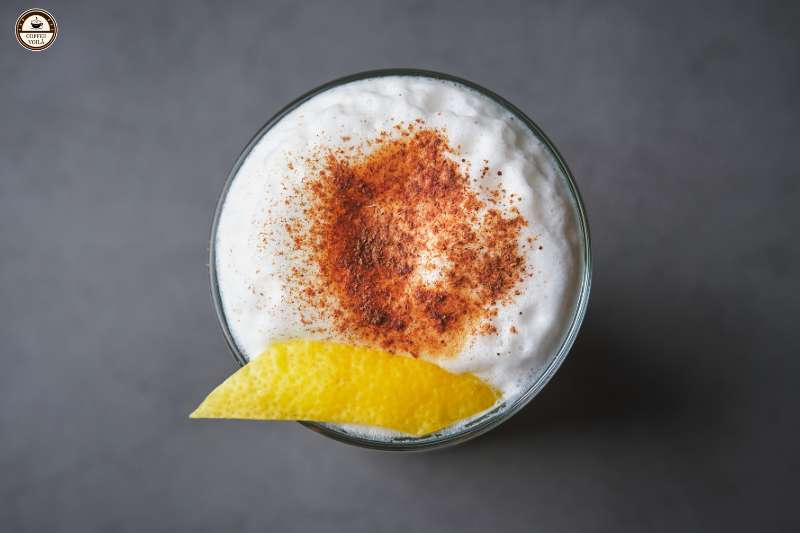
The sweetened condensed milk carries most of the richness anyway, and the vanilla adds enough depth to make it feel like more than your average layered latte.
How to Make It?
Just skip the liqueur entirely or swap in 1–2 teaspoons of vanilla syrup.
I personally love Monin’s Vanilla Syrup for this. It’s got a clean, natural flavor that blends beautifully without overpowering the other layers.
If you want to get extra, you can even infuse the syrup with a bit of lemon peel overnight to mimic that hint of citrus from Licor 43.
Keep the Layering
The rest of the layering stays the same:
- Condensed milk
- Vanilla syrup
- Espresso
- Frothed milk
- Cinnamon (and lemon zest if you like)
It still looks stunning in a glass and tastes like a dessert drink straight out of a Tenerife café.
Last Thoughts
Did you enjoy your Barraquito? Do you have a secret ingredient, layering hack, or family twist you’d like to share?
Maybe your tía swears by adding a dash of nutmeg or you’ve figured out how to layer it perfectly every time without a spoon (seriously, teach us).
Go below and drop your version in the comment. I’d love to hear it. And hey, let’s end with a classic: voilà!
Questions? We Have Answers.
Get answers to a list of the most Frequently Asked Questions.

